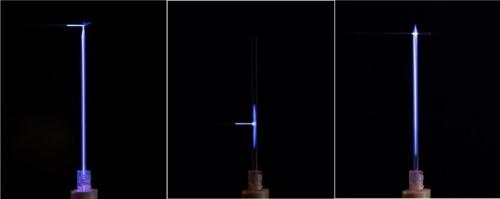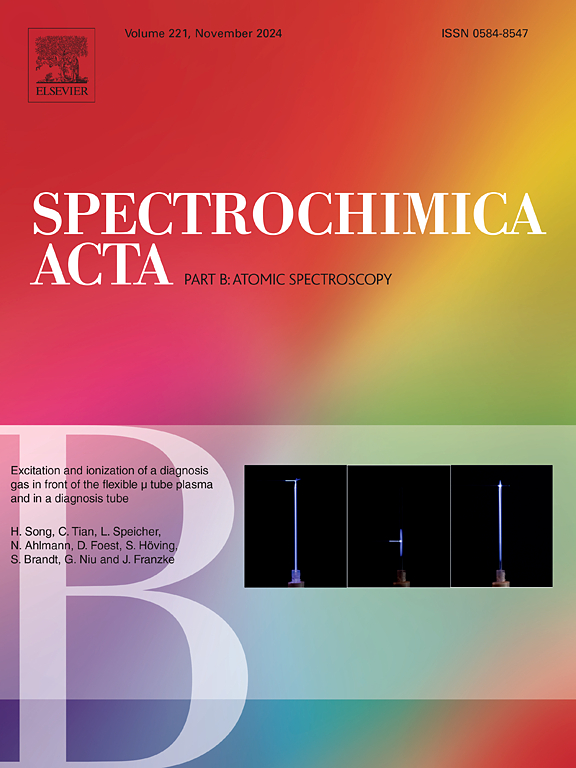Excitation and ionization of a diagnosis gas in front of the flexible μ tube plasma and in a diagnosis tube
IF 3.2
2区 化学
Q1 SPECTROSCOPY
引用次数: 0
Abstract
The noble gases Helium, Argon, Krypton and even Xeon have been applied as discharge gases for the flexible μ tube plasma (FμTP) with comparable ionization efficiencies. It was assumed that a temporally and spatially limited potential plays a major role in the generation of reactant ions responsible for protonation in the surrounding air. However, the excited and ionized species of ambient air cannot be detected directly by emission spectroscopy because there is no known emission wavelength within the detectable range. In this work, a diagnosis gas was introduced as a substitute for the surrounding air to understand the excitation and ionization outside the discharge capillary. It was found that with Ne, Ar, Kr, Xe as plasma gases the diagnosis gas He can be excited during the positive half cycle. The emission of He 706 nm and N2+ 391 nm propagate with and against diagnosis gas flow directions in case of He and Ne driven plasmas. In case of Ar, Kr, and Xe driven plasmas, the emission of both species mainly develops against the diagnosis gas and the shapes of He 706 nm are wide. Further on, the diagnosis gas He is also excited even though there is a glass wall between the plasma gas flow and diagnosis gas flow. These findings demonstrate that the transient potential is responsible for the excitation of the diagnosis gas, not penning ionization or charge transfer between discharge plasma and diagnosis gas.

在柔性 μ 管等离子体前和诊断管内诊断气体的激发和电离
惰性气体氦气、氩气、氪气甚至氙气都被用作柔性μ管等离子体(FμTP)的放电气体,其电离效率相当。据推测,在周围空气中产生负责质子化的反应离子时,受时间和空间限制的电势起着主要作用。然而,由于在可检测范围内没有已知的发射波长,因此无法通过发射光谱直接检测环境空气中的激发和电离物种。在这项工作中,为了了解放电毛细管外的激发和电离情况,引入了一种诊断气体作为周围空气的替代物。研究发现,以 Ne、Ar、Kr、Xe 作为等离子气体时,诊断气体 He 可以在正半周内被激发。在 He 和 Ne 驱动的等离子体中,He 706 nm 和 N2+ 391 nm 的发射随诊断气体的流动方向传播,也可逆向传播。而在 Ar、Kr 和 Xe 驱动的等离子体中,这两种气体的发射主要是逆诊断气体方向传播的,并且 He 706 nm 的波长形状较宽。此外,即使等离子气流和诊断气流之间存在玻璃壁,诊断气体 He 也会被激发。这些发现表明,瞬态电势是诊断气体被激发的原因,而不是放电等离子体和诊断气体之间的电离或电荷转移。
本文章由计算机程序翻译,如有差异,请以英文原文为准。
求助全文
约1分钟内获得全文
求助全文
来源期刊
CiteScore
6.10
自引率
12.10%
发文量
173
审稿时长
81 days
期刊介绍:
Spectrochimica Acta Part B: Atomic Spectroscopy, is intended for the rapid publication of both original work and reviews in the following fields:
Atomic Emission (AES), Atomic Absorption (AAS) and Atomic Fluorescence (AFS) spectroscopy;
Mass Spectrometry (MS) for inorganic analysis covering Spark Source (SS-MS), Inductively Coupled Plasma (ICP-MS), Glow Discharge (GD-MS), and Secondary Ion Mass Spectrometry (SIMS).
Laser induced atomic spectroscopy for inorganic analysis, including non-linear optical laser spectroscopy, covering Laser Enhanced Ionization (LEI), Laser Induced Fluorescence (LIF), Resonance Ionization Spectroscopy (RIS) and Resonance Ionization Mass Spectrometry (RIMS); Laser Induced Breakdown Spectroscopy (LIBS); Cavity Ringdown Spectroscopy (CRDS), Laser Ablation Inductively Coupled Plasma Atomic Emission Spectroscopy (LA-ICP-AES) and Laser Ablation Inductively Coupled Plasma Mass Spectrometry (LA-ICP-MS).
X-ray spectrometry, X-ray Optics and Microanalysis, including X-ray fluorescence spectrometry (XRF) and related techniques, in particular Total-reflection X-ray Fluorescence Spectrometry (TXRF), and Synchrotron Radiation-excited Total reflection XRF (SR-TXRF).
Manuscripts dealing with (i) fundamentals, (ii) methodology development, (iii)instrumentation, and (iv) applications, can be submitted for publication.

 求助内容:
求助内容: 应助结果提醒方式:
应助结果提醒方式:


